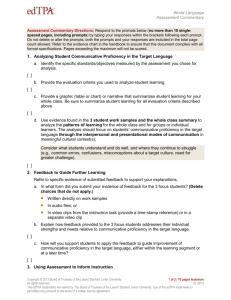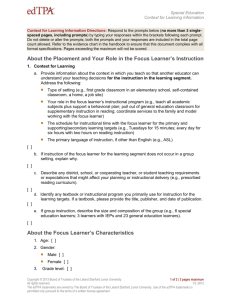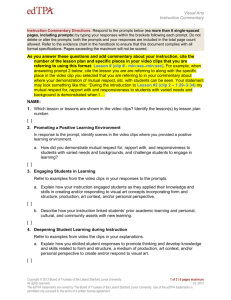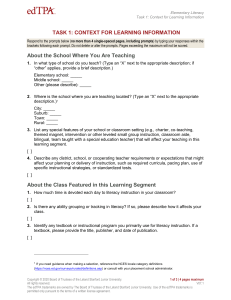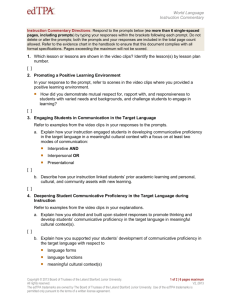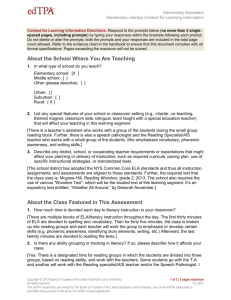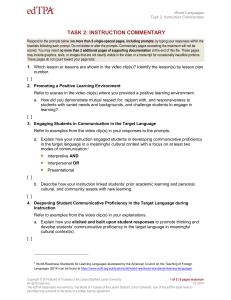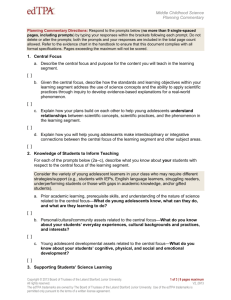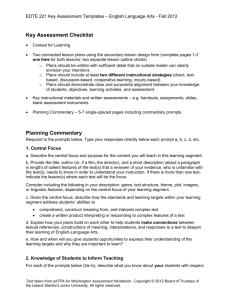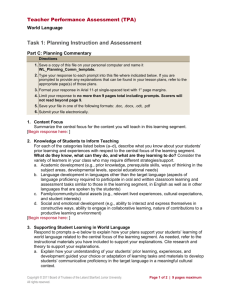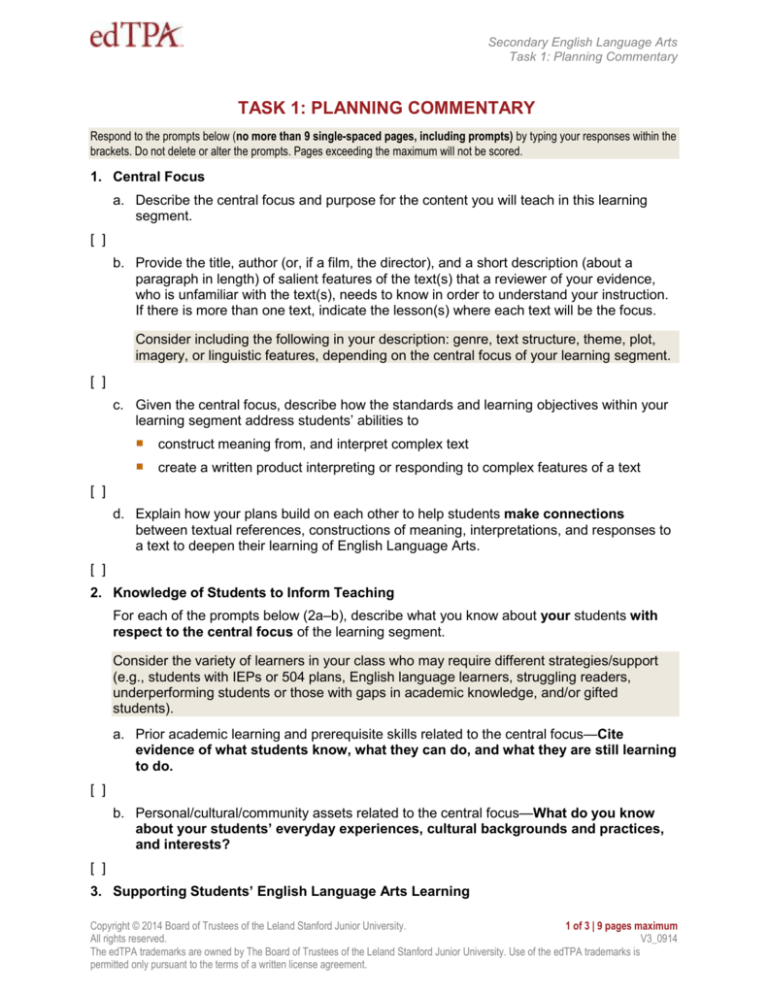
Secondary English Language Arts
Task 1: Planning Commentary
TASK 1: PLANNING COMMENTARY
Respond to the prompts below (no more than 9 single-spaced pages, including prompts) by typing your responses within the
brackets. Do not delete or alter the prompts. Pages exceeding the maximum will not be scored.
1. Central Focus
a. Describe the central focus and purpose for the content you will teach in this learning
segment.
[ ]
b. Provide the title, author (or, if a film, the director), and a short description (about a
paragraph in length) of salient features of the text(s) that a reviewer of your evidence,
who is unfamiliar with the text(s), needs to know in order to understand your instruction.
If there is more than one text, indicate the lesson(s) where each text will be the focus.
Consider including the following in your description: genre, text structure, theme, plot,
imagery, or linguistic features, depending on the central focus of your learning segment.
[ ]
c. Given the central focus, describe how the standards and learning objectives within your
learning segment address students’ abilities to
construct meaning from, and interpret complex text
create a written product interpreting or responding to complex features of a text
[ ]
d. Explain how your plans build on each other to help students make connections
between textual references, constructions of meaning, interpretations, and responses to
a text to deepen their learning of English Language Arts.
[ ]
2. Knowledge of Students to Inform Teaching
For each of the prompts below (2a–b), describe what you know about your students with
respect to the central focus of the learning segment.
Consider the variety of learners in your class who may require different strategies/support
(e.g., students with IEPs or 504 plans, English language learners, struggling readers,
underperforming students or those with gaps in academic knowledge, and/or gifted
students).
a. Prior academic learning and prerequisite skills related to the central focus—Cite
evidence of what students know, what they can do, and what they are still learning
to do.
[ ]
b. Personal/cultural/community assets related to the central focus—What do you know
about your students’ everyday experiences, cultural backgrounds and practices,
and interests?
[ ]
3. Supporting Students’ English Language Arts Learning
Copyright © 2014 Board of Trustees of the Leland Stanford Junior University.
1 of 3 | 9 pages maximum
All rights reserved.
V3_0914
The edTPA trademarks are owned by The Board of Trustees of the Leland Stanford Junior University. Use of the edTPA trademarks is
permitted only pursuant to the terms of a written license agreement.
Secondary English Language Arts
Task 1: Planning Commentary
Respond to prompts 3a–c below. To support your justifications, refer to the instructional
materials and lesson plans you have included as part of Task 1. In addition, use principles
from research and/or theory to support your explanations.
a. Justify how your understanding of your students’ prior academic learning and
personal/cultural/community assets (from prompts 2a–b above) guided your choice or
adaptation of learning tasks and materials. Be explicit about the connections between
the learning tasks and students’ prior academic learning, assets, and research/theory.
[ ]
b. Describe and justify why your instructional strategies and planned supports are
appropriate for the whole class, individuals, and/or groups of students with specific
learning needs.
Consider students with IEPs or 504 plans, English language learners, struggling readers,
underperforming students or those with gaps in academic knowledge, and/or gifted
students.
[ ]
c. Describe common student errors or misunderstandings within your central focus and
how you will address them.
[ ]
4. Supporting English Language Arts Development Through Language
a. Language Function. Identify one language function essential for students within your
central focus. Listed below are some sample language functions. You may choose one
of these or another more appropriate for your learning segment.
Analyze
Argue
Describe
Evaluate
Explain
Interpret
Justify
Synthesize
[ ]
b. Identify a key learning task from your plans that provides students with opportunities to
practice using the language function identified above. Identify the lesson in which the
learning task occurs. (Give lesson day/number.)
[ ]
c. Additional Language Demands. Given the language function and learning task
identified above, describe the following associated language demands (written or oral)
students need to understand and/or use:
Vocabulary
Plus at least one of the following:
Syntax
Discourse
Consider the range of students’ understandings of the language function and other
language demands—what do students already know, what are they struggling with,
and/or what is new to them?
Copyright © 2014 Board of Trustees of the Leland Stanford Junior University.
2 of 3 | 9 pages maximum
All rights reserved.
V3_0914
The edTPA trademarks are owned by The Board of Trustees of the Leland Stanford Junior University. Use of the edTPA trademarks is
permitted only pursuant to the terms of a written license agreement.
Secondary English Language Arts
Task 1: Planning Commentary
[ ]
d. Language Supports. Refer to your lesson plans and instructional materials as needed
in your response to the prompt.
Describe the instructional supports (during and/or prior to the learning task) that help
students understand and successfully use the language function and additional
language demands identified in prompts 4a–c.
[ ]
5. Monitoring Student Learning
In response to the prompts below, refer to the assessments you will submit as part of the
materials for Task 1.
a. Describe how your planned formal and informal assessments will provide direct
evidence of students’ abilities to construct meaning from, interpret, AND/OR respond to
a complex text throughout the learning segment.
[ ]
b. Explain how the design or adaptation of your planned assessments allows students with
specific needs to demonstrate their learning.
Consider all students, including students with IEPs or 504 plans, English language
learners, struggling readers, underperforming students or those with gaps in academic
knowledge, and/or gifted students.
[ ]
Copyright © 2014 Board of Trustees of the Leland Stanford Junior University.
3 of 3 | 9 pages maximum
All rights reserved.
V3_0914
The edTPA trademarks are owned by The Board of Trustees of the Leland Stanford Junior University. Use of the edTPA trademarks is
permitted only pursuant to the terms of a written license agreement.

